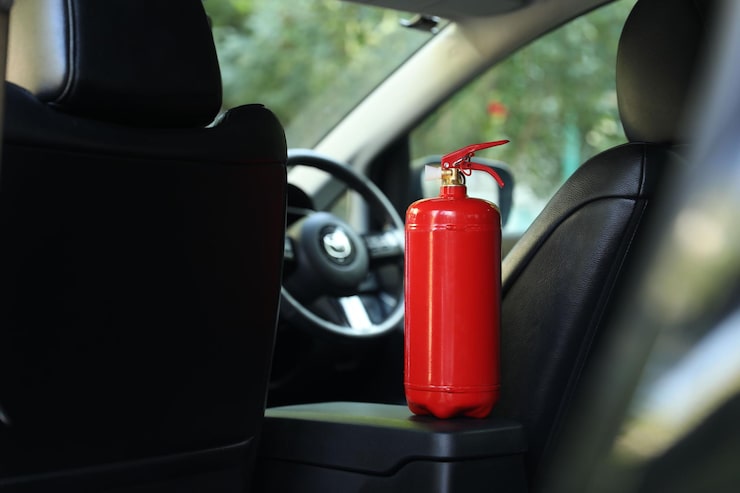
How Smart Systems Prevent Car Fires
Modern vehicles are advanced electrical and mechanical systems, and with them, a new generation of threats: vehicle fires due to system malfunction, overheating, or fuel leaks. Fortunately, technology is keeping pace. In this blog, we look at how smart fire suppression systems, powered by sensor-based detection and microprocessor control, are transforming automobile fire safety. With case studies, scientific explanations, and references to real-world applications, we’ll show how innovations like Auto Burn Stop can detect, analyze, and extinguish fires autonomously. This isn’t just about convenience; it’s about life-saving automation rooted in cutting-edge science.
Evolution of Fire Suppression in Vehicles
Drivers have been relying on physical equipment, basic extinguishers and safety hammers, to control accidents for years. As motors evolved, however, the risk grew more complex too. The need for an intelligent fire suppression system without human intervention increased in significance.
Modern fire suppression systems of today’s best drivers integrate suppression agents, distribution systems, and onboard intelligence to respond within seconds of ignition. Not only reactive, these systems are made proactive as well.
Auto Burn Stop illustrates this strategy, integrating sensor-based detection, algorithmic reasoning, and immediate deployment through a central microprocessor control unit. Its modular, automated design guarantees fires are put out even if the driver is incapacitated or the car is in motion.
Sensor-Based Detection
At the core of all smart fire suppression systems is sensor-based detection. These sensors pick up on temperature changes, smoke particulate, concentrations of vapors, or even the signature chemicals released during combustion. Unlike the older sensors, which only respond after a flame can be visually detected, modern systems predict ignition based on anomaly patterns.
For instance, sensor-based detection in Auto Burn Stop consists of thermal sensors installed near batteries, engine compartments, and fuel lines. A sensor sends the information to the microprocessor control unit when it detects rapid heat accumulation or flammable gas concentrations. This is how Auto Burn Stop anticipates danger and suppresses it prior to total ignition.
Recent research (Fire Technology, 2022) has shown that the use of smart sensor-based detection can reduce fire growth by over 60% when applied in high-risk regions like fuel rail systems.
Microprocessor Control
Modern fire prevention relies squarely on microprocessor control. A microprocessor control module is interpreting data from dozens of sensors and determining the course of action. It is recognizing patterns, as opposed to isolated events, and matching real-time sensor input to known risk profiles.
In Auto Burn Stop, this control unit is the decision maker. It runs a real-time analysis of engine heat, vapor density, and component heating rates. When it detects a threat profile, it engages the fire suppression system. It also separates benign variations (like normal engine heat) from hazardous threats, minimizing false alarms.
This system uses predictive modeling, the same ones used in aerospace and industrial risk identification (IEEE Transactions on Systems, 2023). It is not just logic-based, it is data-driven safety management.
Integration with Vehicle Design and Architecture
A robust fire suppression system must fit comfortably into the vehicle without sacrificing performance or space. This is where modular design, miniaturized extinguishing agents, and elastic piping systems come into play. But it means nothing without precise sensor-based sensing and a good microprocessor control system.
Auto Burn Stop is also designed to retrofit into nearly any vehicle model. Its hardware does not interfere with any other systems, and its automatic modules operate in their own private mode. Because of this, it’s especially useful for fleet operators who have a number of different vehicles. Each automobile becomes its own smart safety node, thanks to the uniform application of sensor-based detection and centralized microprocessor control.
This level of integration also provides diagnostic alerts and remote support center communication, which further adds accountability and effectiveness to the maintenance.
Advantages of Proactive Suppression Systems
Unlike conventional extinguishers that respond after fires break out, smart fire suppression systems act proactively. The systems operate behind the scenes, monitoring all pertinent fire risk factors at all times. The system can douse an engine fire even as the vehicle continues running, and sometimes even before the driver has a chance to be aware of any issue.
Products like Auto Burn Stop redefine safety by combining sensor-based detection with microprocessor control on one platform. It is not merely a matter of salvaging the car, but saving lives. Where most car fires get spread within less than 90 seconds, every second saved through automation means something.
Scientific tests (Journal of Safety Science, 2023) confirm combined fire suppression systems save 35% lives over traditional methods. It’s a technological innovation driven not just by technology, but by science on how fires propagate.
Conclusion
As cars become more intelligent, so must safety systems in them. No longer can it be a nicety for a car to have the ability to sense early indications of fire and, through automated means, put it out, it must be a necessity. Auto Burn Stop technology, powered by sensor-based sensing and governed through adaptive microprocessor control, is the future of real-time automated fire protection.
We are migrating from passive safety to active prevention. And with smarter and smarter fire suppression systems available, universal application is no longer a question of cost, it’s one of scientific and moral responsibility.



